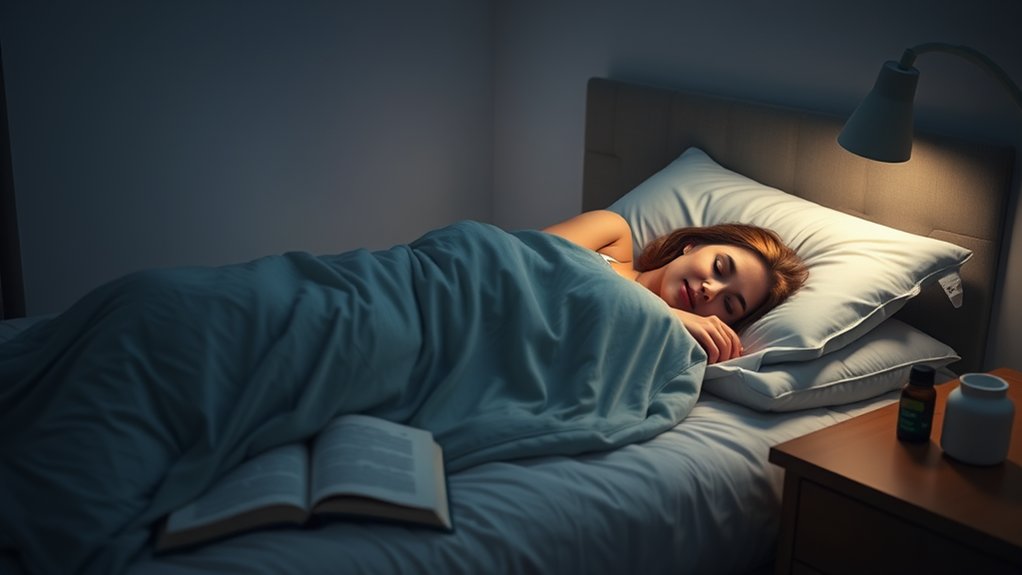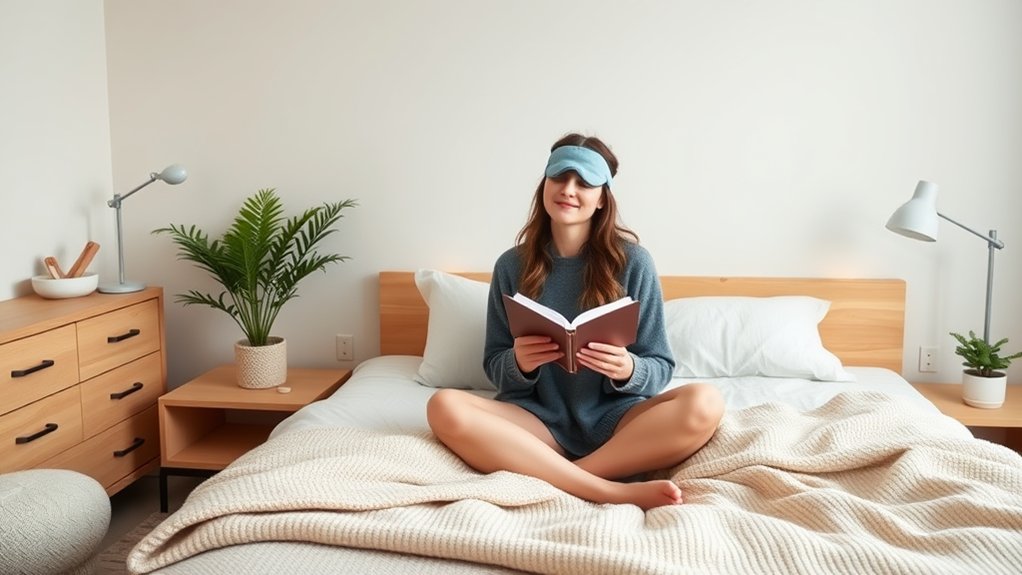How to Fall Asleep When Anxiety Strikes

Okay, dude, if anxiety’s got you tossing and turning, try these tips to catch some damn Z’s. Ditch the screens, take a relaxing bath, and light some soothing candles. Do some deep breathing and visualize those mountain views – it’ll chill you the hell out. Tense and release those muscle groups, create a cozy sleep sanctuary, and shift focus from anxious thoughts. Wanna learn more about kicking that insomnia for good? Keep reading.
Establish a Calming Bedtime Routine
Alright, listen up. Establishing a calming bedtime routine is essential for falling asleep with anxiety.
First, ditch the goddamn screens at least an hour before bed – the blue light’ll keep your brain wired. Instead, take a relaxing bath, do some light stretching, or read a damn book.
Ditch the damn screens at least an hour before bed – the blue light’ll keep your brain wired. Instead, relax with a bath, stretching, or a good book.
Scented candles or essential oils can also work wonders to soothe your anxious mind. And don’t forget to journal – get all those racing thoughts out of your head and onto paper.
Avoid caffeinated drinks after noon, and stick to the same sleep and wake times, even on weekends. Trust me, your body’ll thank you.
Before you know it, you’ll be drifting off into a peaceful slumber, anxiety-free.
Breathing Exercises for Relaxation
Breathing exercises can be a game-changer when it comes to kicking that anxiety to the curb before bed.
Take a deep breath, my friend. Inhale through your nose, hold it for a beat, then exhale slowly through pursed lips. Do this a few times, and you’ll feel that tension melt away.
Try visualizing a peaceful scene – a sunny beach, a snowy mountain, or even your cat curled up purring. Pair this with some light stretches, and you’ll be one step closer to dreamland.
Don’t believe me? Just give it a shot. What do you have to lose, other than a crappy night’s sleep?
Progressive Muscle Relaxation Techniques
If you’re sick of tossing and turning, trying to outmaneuver that stubborn anxiety, then listen up. Progressive muscle relaxation is a powerful technique that can help you fall asleep like a rock.
Here’s how it works: You systematically tense and then relax different muscle groups in your body, allowing you to release physical tension and mental stress. It’s like a mini-massage, except you’re the one in control.
| Step | Muscle Group | Action |
|---|---|---|
| 1 | Feet and toes | Tense for 5 seconds, then relax |
| 2 | Legs | Tense for 5 seconds, then relax |
| 3 | Stomach and chest | Tense for 5 seconds, then relax |
| 4 | Arms and hands | Tense for 5 seconds, then relax |
Give it a try, you lazy bum. Ditch the anxiety and drift off to dreamland. Trust me, your body and mind will thank you.
Creating a Sleep-Conducive Environment
Creating a sleep-conducive environment is key, so don’t screw this up. Your bedroom should be a sanctuary, not a circus.
Ditch the distractions – we’re talking no TVs, no phones, no computers. The only things allowed are your bed, some comfy PJs, and maybe a good book.
Crank down the temperature to a cool, cozy level. Invest in some blackout curtains or an eye mask if the streetlights are keeping you up. White noise machines can also work wonders, drowning out those annoying neighborhood sounds.
Finally, make sure your mattress and pillows aren’t complete trash. They should be supportive yet comfortable, not feel like you’re sleeping on a bed of rocks.
Get your environment right, and falling asleep will be a hell of a lot easier.
Cognitive Behavioral Strategies for Anxiety
Alright, now that we’ve set up the ideal sleep environment, let’s talk about how to actually get your mind to shut the hell up when it’s time to hit the sack.
Cognitive behavioral strategies are all about retraining your brain to stop obsessing over anxious thoughts when you’re trying to wind down. First, identify those pesky worry spirals and consciously shift your focus to something mundane, like counting backward from 100.
Or picture a soothing, peaceful scene in vivid detail. Breathe deeply and repeat a simple mantra, like “I am safe, I’m calm.” The key is interrupting that anxious inner monologue before it snowballs.
It takes practice, but with time, you can train your brain to cooperate when all you want is some damn sleep.
Incorporating Mindfulness Practices
In addition to the cognitive strategies we just covered, incorporating mindfulness practices can be incredibly helpful for drifting off with a restless mind.
Mindfulness is all about being present, focused, and non-judgmental – three things that are the exact opposite of the anxious mind’s usual ramblings.
Try these four tips:
- Take some deep belly breaths. Inhale for 4 seconds, hold for 4 seconds, exhale for 6 seconds. Repeat until you feel the tension melt away.
- Do a quick body scan, noticing any areas of tightness or tension, and consciously relax them.
- Visualize a peaceful, calming scene – maybe a beach, forest, or your favorite cozy spot.
- Silently repeat a simple mantra like “I am safe” or “This too shall pass” to anchor your mind.
Avoiding Stimulants and Disruptive Habits
Of course, all that deep breathing and visualization ain’t worth squat if you’re chugging down coffee or knocking back energy drinks right before bed.
Those stimulants may keep you wired and awake when you should be snoozing.
And let’s not forget about alcohol – it may help you fall asleep initially, but it’ll mess with your sleep cycle and leave you feeling like crap in the morning.
Ditch the habits that disrupt your sleep, and you’ll have a much better shot at catching those elusive Zs.
No more binge-watching Netflix until 2 AM, either.
Yep, that means putting down the phone and powering off the TV at least an hour before bedtime.
Your brain needs time to wind down, so make it happen, alright?
Final Thoughts
Alright, listen up! When anxiety’s got you by the throat and you can’t catch a wink, don’t fret – these techniques will have you snoozing like a baby in no time. From deep breaths to muscle magic, we’ve got your back. So, ditch the caffeine, get cozy, and let your worries melt away.
And if you find that nighttime anxiety still lingers, consider exploring the ‘Sleep Return’ program. With a gentle, trauma-informed approach, it focuses on nurturing your nervous system to create a safe space for rest. Sweet dreams, my friend — because you deserve to feel at ease and truly restful each night.






